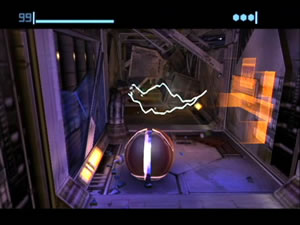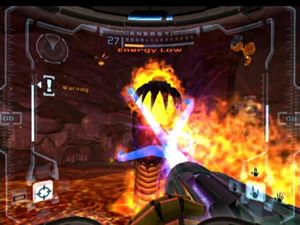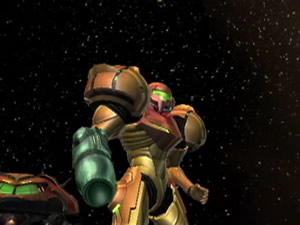A life of Prime.
The Space Pirates of Zebes aren’t your typical band of no-good scallywags with
eye patches shouting “Arrrr, matey!” but they sure are nasty. When these scourges
aren’t ravaging planets into smoldering hunks of rock, they can be found dabbling
with the mutagenic mineral Phazon in a plot to create the perfect pirate.
These
villains have set up camp on the Phazon-rich planet of Tallon IV, once home
to a sect of peaceful Chozo who have long since vanished. Grossly simplified,
the Chozo are a race of cosmic space birds that dig philosophy. Long ago, the
Chozo raised an orphaned human girl to be their savior. That girl is Samus Aran.
Metroid Prime marks Samus Aran’s foray into the realm of first-person
gameplay. Across nearly every Nintendo system, her adventures battling pirates
have always taken place in two dimensions. This time around, you are
Samus as you step into her shoes, er, Chozo Space Armor, and see Tallon IV through
her eyes in one of the most impressive, atmospheric adventures to date.
Right off the bat, you’ll notice that Metroid Prime does not operate
like your standard console FPS with dual stick controls. Instead, the game employs
a lock-on targeting system, faintly reminiscent of Zelda:
Ocarina of Time but from a first-person perspective. The lock-on key enables
opponent-centric strafing as well as normal strafing when there isn’t anything
to target. The main analog stick switches between basic movement and aiming.
While this may sound restrictive and a bit confusing, this is a different style of gameplay with a different sense of combat. Though it does take some getting used to, the controls prove to be a strength as you lock down on some enemy whizzing through the air at top speeds, all while jumping around and using the terrain to your advantage.
The ability to lock-on doesn’t mean combat is effortless, either. A good sense of timing and quick dodging are still needed to make clean attacks – a combination of quick aiming and locking can smoothly be used to pin down an aerial attack or quickly pick out and nail a specific grounded predator.
This style of combat encourages dispatching enemies from a distance. Close
combat in tight spaces against stronger enemies will usually be deadly thanks
to the decrease in mobility – the closer you are, the less room there is to
avoid danger with evasive strafing and dash jumps. The creepy bosses require
the classic patterns and combinations and make full use of lock-on techniques.
You won’t breeze through these puppies on your first try.
Platforming has long been a staple of any Metroid game, and here it
has a pleasant and forgiving feel despite the lack of a more clearly delineated
third-person view. Sadly, Samus’ trademark spin jump and screw attack are gone,
save for the handful of cut scenes that show her spinning into action
What keeps the platforming interesting is the element of exploration – looking
around, searching for that next place to jump, the next crevice to explore.
The exploratory roots take precedence over the combat, but the two mesh with
and balance each other beautifully. Like many gamers I had my misgivings, but
it truly feels like a Metroid game.
 As
As
in past Metroid games, Samus starts out as a penniless hobo, bereft of
any supplies or powers. Why doesn’t she keep an extra Morph ball in her spaceship
or an energy tank in the glove compartment? Because that would be too simple.
As she treks out in her weakened state towards the vacuous unknown, most of
Tallon IV is inaccessible. The ledges are just too high or there’s some obstacle
in the way. As Samus explores further, she finds various upgrades that enable
her to reach those previously unattainable areas.
Tallon IV opens itself up through well-woven level design and a strong sense
of pacing. The clear, built-in mapping system is easy to control and truly helpful.
The default hint system gives the occasional nudge in the right direction, but
doesn’t let on enough to spoil the game. Purists can choose to switch it off.
The various suit upgrades enable Samus to withstand dangerous temperature zones,
and at times increase mobility. A grappling hook allows her to swing from marked
locations. The morph ball and its various additions allow Samus to bundle herself
up and roll into inaccessible tunnels via a third-person perspective switch.
Similar to the ice, fire, and light arrows of Majora’s
Mask, the four weapons (Power, Wave, Ice, and Plasma) are cleverly used
to not only open different doors, but also eliminate certain enemies who are
susceptible only to specific weapons.
Instead of pausing the action in a tense moment to change equipment, the C-stick
and the D-pad are used to efficiently swap between the different weapons and
visors in the heat of action. The original Scope ability from Super Metroid
has been amped up several notches, granting Samus several Visors with which
to examine the environment in new ways. These different Visors are actually
useful to the gameplay and feature markedly different views. In pure darkness,
the thermal visors can be used to track down the wayward foe. Invisible objects
and doorways hidden behind solid walls of rock require the handy X-ray visor.
Samus’ helmet and the heads-up display on her visor are an actual part of
the screen image. Globs of mucous goo or the heat of condensation can build
up on the glass. At first, it’s almost claustrophobic to peer out of her helmet,
but once you are used to it, it definitely heightens the sense of immersion.
Nonetheless, there is the option to adjust the transparency of the helmet and
HUD overlays.
 The
The
sense of being Samus is really found in the details. With just the right
flash of light or glare against the visor, a thin, hazy reflection of Samus
can be seen against the inner glass. It’s quite cool.
And this kind of detail is everywhere. Space pirates can be knocked off high
beams and their dead corpses can slide down inclined ramps. A charged power
shot envelopes outward, distorting the image in its blast. The Plasma beam completely
melts the icy Baby Sheegoths, complete with a new incineration animation. The
modeling of the environments and a sense of otherworldliness shine in the vivid
imagery, through the layers of falling snow stretching across a chilly valley
to the rising sun casting its orange-red glare on eroding stones and parched
sands. You really feel like you’re on another planet.
Through it all, there isn’t a single loading screen. Each new environment
is streamed in during those few seconds a door takes to open or while traveling
by elevator.
The sound effects are true to their roots, with every blast and shriek resounding
in a twinge of nostalgia. Instead of the ‘whirl’ of Samus’ spin jump, there’s
the pleasing electric hum of her morph ball. The music is richly atmospheric,
created by the same original composer of the old Metroid games, Kenji
Yamamoto. The Phendrana Drifts region has a calm, operatic melody; elsewhere,
there are edgy remixes of classic Metroid music. The emergency “in-danger”
music can get a touch grating, but that only pushes you to eliminate the increment
threats that much faster.
Instead of drawn-out cut scenes, Metroid Prime employs participatory
storytelling via the Scan Visor. By scanning various enemies and computers,
you can read up on everything from Chozo and Pirate diary entries to records
and descriptions of every enemy in the game. Even though there isn’t much plot
found within these diaries, the writing is done well. Samus comes out in the
end as the same Samus we’ve always known – a stoic, graceful, silent ass-kicker.
In yet another impressive feat, Metroid Prime can be connected to the
newly released Metroid Fusion via the Game Boy Advance Link, unlocking
two bonus features. Completing Fusion unlocks the entire original Metroid
on the Gamecube. They’ve actually improved upon the original Metroid
by adding the ability to save within the game. Completing Prime opens
up the ability to play Metroid Prime with a Fusion suit. This
change is only cosmetic, as it doesn’t grant Samus any new voodoo powers or
the ability to talk with the Metroids. Now there’s an idea…
I haven’t felt this close to being an intergalactic space mercenary since
I was poorly dressed up as Samus eons ago for Halloween. Hey, at the time, nobody
knew she was a girl. But hours after I beat Metroid Prime, I could feel
the urge, like the shakes, to again don the armor and make my way into Tallon.
Despite all the arguments that Metroid should have been in the third
person, this is a fantastic, top-notch effort and a simple must-have for anyone
with a Gamecube. Be Samus – play Metroid Prime.

-
Atmospherically beautiful, full of details
-
Surprisingly good control
-
Nice writing in short entries
-
Huge, seamless world, rife with secrets
-
Well paced, with difficultly in the right areas
-
Great sound
-
Steep learning curve







